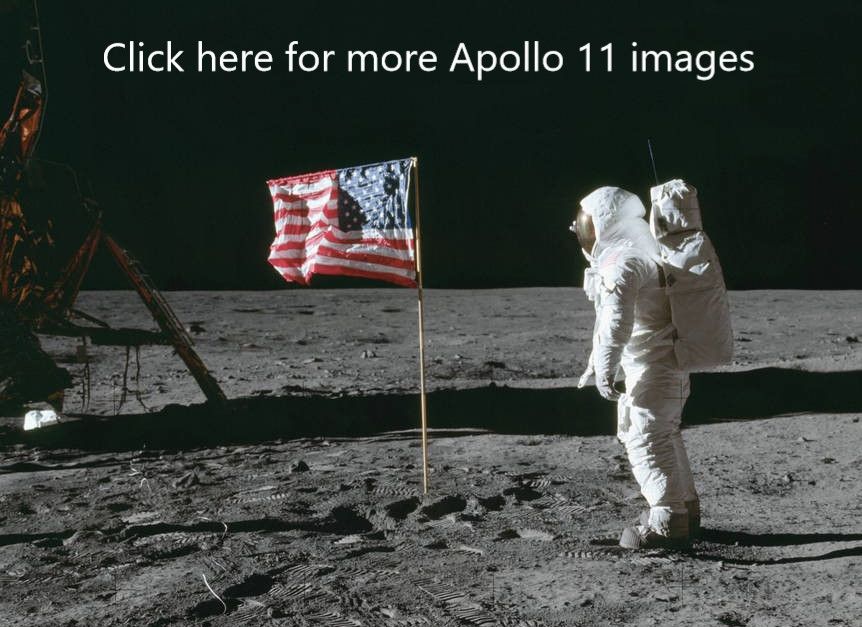The first man to set foot on the Moon 50 years ago this summer is remembered by his friend and colleague, a former astronaut and administrator at NASA.
-
Summer 2019
Volume64Issue3
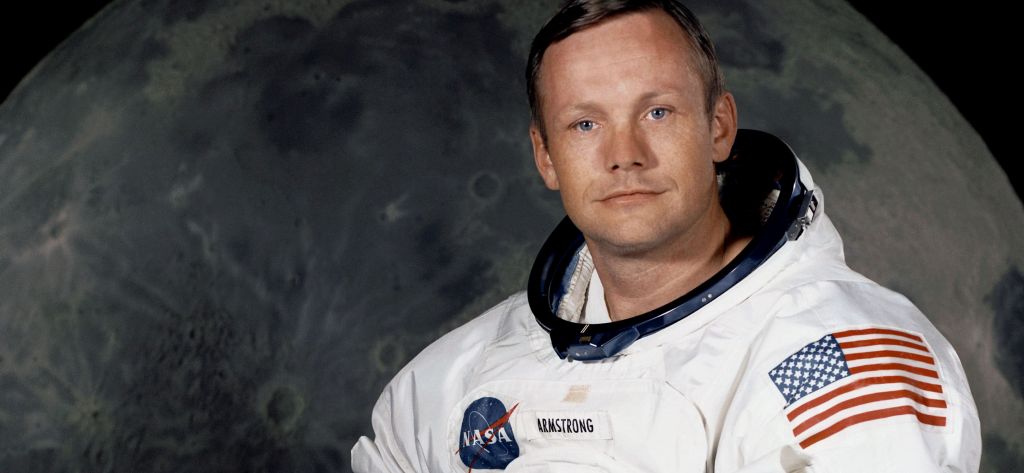
As long as there are history books, Neil Armstrong will be in them.
In May 1961, President John F. Kennedy had committed the nation “to achieving the goal, before the decade is out, of landing a man on the Moon and returning him safely to Earth.” A little over eight years later, on July 20, 1969, Neil Armstrong commanded the Apollo 11 mission that simultaneously ended the Soviet-American space race and met America’s goal with more than five months to spare.
“Roger, Tranquility,” CapCom Charlie Duke in mission control replied. “We copy you on the ground. You’ve got a bunch of guys about to turn blue. We’re breathing again. Thanks a lot.”
The same could have been said for hundreds of millions of people around the world watching on black-and-white television.
Armstrong, with Colonel Edwin E. “Buzz” Aldrin Jr. at his side, steered their lunar landing craft Eagle to a lunar plain close to the southwestern shore of the Sea of Tranquillity. With the world watching, onboard computer alarms sounding, and the fuel extremely low and getting lower, Armstrong was in his element. He skimmed over large boulders covering the planned landing site, and softly touched down.
His words to Houston were as historic as his deed: “Houston, Tranquillity Base here, the Eagle has landed.”
About 6 1/2 hours after landing, with a television camera watching every step, Armstrong climbed down Eagle’s ladder, set his feet in the lunar dust, and said: “That’s one small step for [a] man, one giant leap for mankind.”
The moonwalk lasted 2 hours and 19 minutes, long enough to let Armstrong and Aldrin test their footing and set up an American flag, a television camera, and scientific instruments to collect rock samples.
Apollo 11 left a plaque on the Moon, attached to Eagle’s ladder leg, which Armstrong read aloud: “Here men from the planet Earth first set foot upon the moon. July 1969 AD. We came in peace for all mankind.”
Aboard the spacecraft Columbia about 60 miles overhead, Michael Collins circled in lunar orbit awaiting Armstrong and Aldrin’s return. Collins played a crucial role throughout the mission, especially in ensuring a safe docking in lunar orbit prior to returning to Earth.
Apollo 11 capped a tumultuous and consequential decade that saw three assassinations, rioting in American streets, and the buildup of the Vietnam War. But Armstrong’s flying skills had allowed human beings to finally reach that longtime symbol of the unreachable.
Armstrong Alden Armstrong was born on August 5, 1930, on his grandfather’s farm five miles west of the small town of Wapakoneta, Ohio, to Stephen Armstrong and the former Viola Louise Engel. His father was a state auditor, which caused the Armstrong family to move every few years to a new Ohio town while Armstrong was growing up. The Armstrong family was back in Wapakoneta, however, when Neil finished the local Blume High School at age 16. Like so many future astronauts, Armstrong earned his Eagle Scout badge.
One day at about the age of six, Armstrong and his father skipped Sunday school and his Dad took him on a ride in a Ford Trimotor airplane, known as the Tin Goose. Later, in an oral history, Armstrong said that he didn’t remember the flight, but it must have impressed him, for he soon became an avid model airplane builder. Building model airplanes was an interest that followed him from home to the Scouts and later to Purdue University and the Navy. He built a rudimentary wind tunnel by age 14 and by age 15, before he got his driver’s license, he had learned to fly.
Armstrong won a Navy scholarship and entered Purdue University as an engineering student in 1947. In First Man: The Life of ArmstrongArmstrong, James R. Hansen wrote that in Armstrong’s first year at Purdue, Chuck Yeager broke the sound barrier in the rocket-powered Bell X-1. It was exciting but bittersweet for young Neil. He thought aviation history had already passed him by.
“All in all, for someone who was immersed in, fascinated by, and dedicated to flight,” Armstrong told his biographer, “I was disappointed by the wrinkle in history that had brought me along one generation late. I had missed all the great times and adventures in flight.”
The Navy had other ideas, and interrupted his college years. In 1949 Armstrong was ordered to Pensacola for flight training. He won his Navy wings 18 months later as a “flying midshipman.”
Armstrong was an ensign by the time he was flying Grumman F9F-2 Panthers and the youngest pilot in the VF-51 Screaming Eagles, which deployed off the Korean coast aboard the USS Essex (CV-9). Another pilot in the squadron was Lieutenant Tom Hayward, a future Chief of Naval Operations. Armstrong flew 78 combat missions, and on September 3, 1951, on a high-speed, very low run he flew into a cable that severed several feet of his Panther’s starboard wing. He fought the damaged aircraft’s controls until he was over friendly territory before ejecting. Two days later, he was back in combat. It was a hellish cruise for the Essex, which suffered 27 Navy fatalities and saw a major flight deck fire.
Armstrong recalled that the author James A. Michener, fresh off a Pulitzer Prize for Tales of the South Pacific, was an Essex guest in late 1951, and would sit in the VF-51 ready room listening to stories of the guys coming off combat missions. The result was Michener’s novel The Bridges at Toko-Ri.
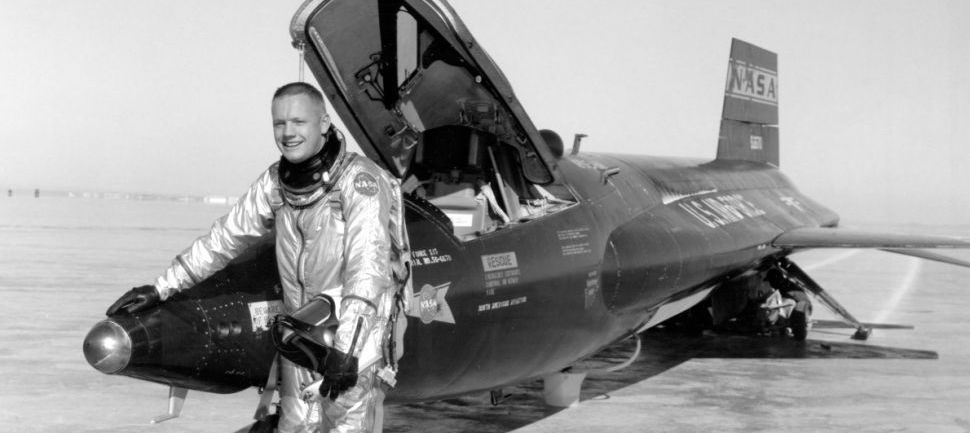
Back at Purdue after the Navy, Armstrong plunged more earnestly into aeronautical engineering studies, his grades rising and a career in sight. In his first year back, he also met Janet Shearon, a freshman student in home economics from Evanston, Illinois.
Armstrong had set his sights on becoming an experimental test pilot, and soon after his graduation landed an engineering and flying job at the National Advisory Committee on Aeronautics’ Lewis Center in Cleveland. But within five months he moved to the NACA High Speed Flight Station (later the NASA Dryden Flight Research Center) in the Mojave Desert at Edwards, California, legendary home to the X-planes. A few months later, in January 1956, Neil and Jan were married. They had two sons, Eric and Mark, and a daughter, Karen.
His first flight in a rocket plane was in the Bell X-1B, a successor to the plane Yeager had first flown faster than the speed of sound. Armstrong impressed his peers. Another NACA test pilot, Bill Dana, said he “had a mind that absorbed things like a sponge and a memory that remembered them like a photograph.” Armstrong eventually flew seven X-15 flights, reaching the edge of space, and piloted many more of the most innovative and dangerous research aircraft ever developed.
One evening during their early years in California, Neil and Jan attended a lecture by Wernher von Braun in Lancaster. They were surrounded by many interested NACA leaders and test pilots, and heard von Braun say that based on his experience, he believed that a rocket could be built to carry the required load for man to explore space. Jan remembered, “It was the first time I had ever dreamed of a possibility of space travel…. This was an eye opener for me.”
It was also during the mid-50s that the Society of Experimental Test Pilots was born; Armstrongwas a charter member. During the first SETP banquet in October 1957, the Soviet Union shocked the world by launching Sputnik.
Even before NASA selected the first Mercury astronauts, Armstrong was involved in not one but two space programs. In June of 1958, at the age of 27, he was one of nine test pilots selected for the USAF Man in Space Soonest program, designed to put a man into outer space before the Soviet Union did. The program was short-lived. That same year, Neil was chosen as a NACA (later NASA) consultant for a military space plane project, the X-20 Dyna-Soar, and in 1960 was secretly named one of the astronauts. The Dyna-Soar was being designed and developed for the USAF by Boeing in Seattle, Washington.
Jan and the children joined Armstrong on several trips to Seattle, and it was here in the summer of 1961 that tragedy struck the family. On an outing to a local park, two-year-old Karen, whom Jan and Armstrong called Muffie, took a childhood spill. But the knot on her head led to a series of tests back in California, resulting in a diagnosis of an inoperable brain tumor. After six agonizing months, Karen died in January 1962.
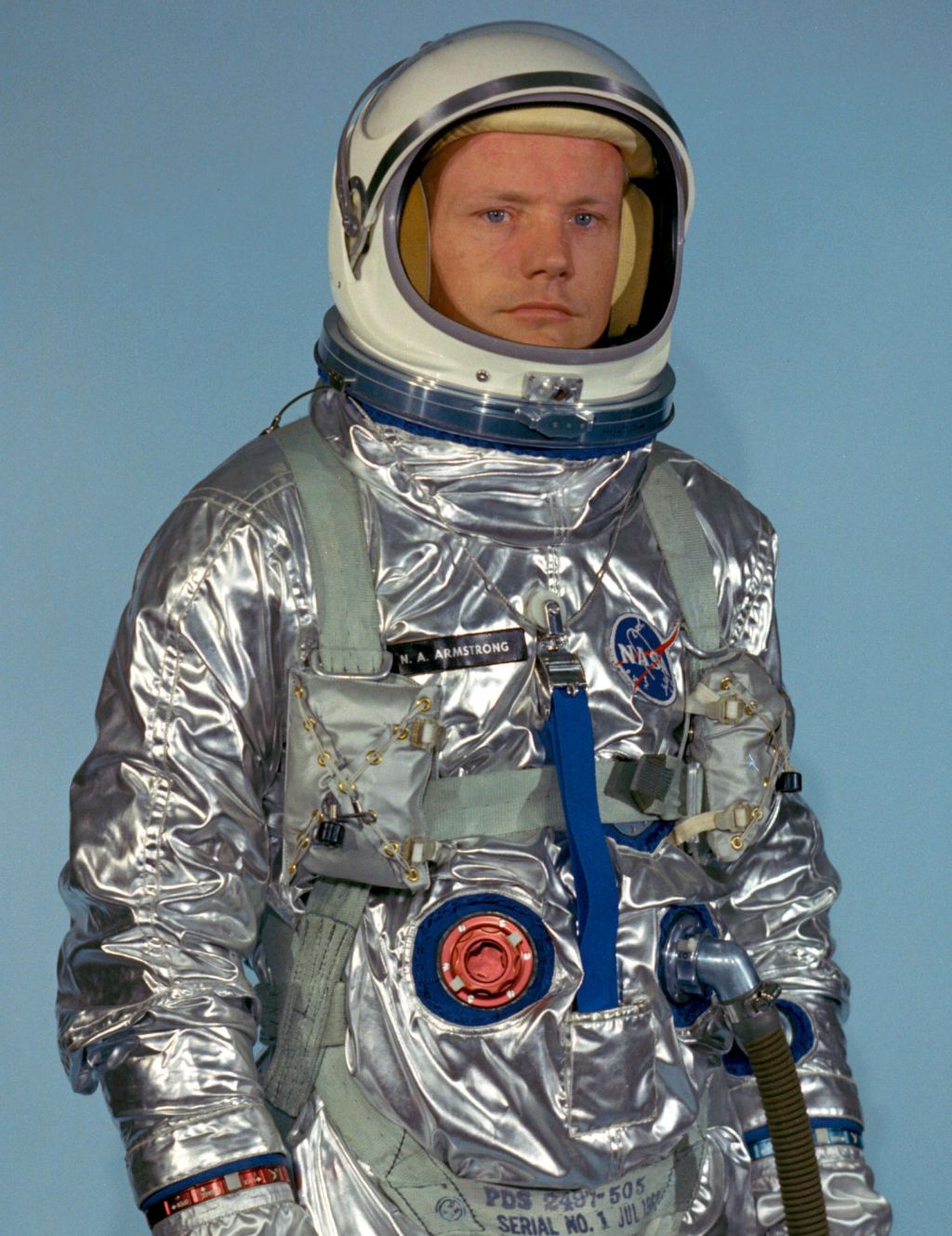
Soon after Armstrong returned to his X-15 engineering and flying, he was attracted by another opportunity. NASA was receiving applications for the second group of astronauts, following the Mercury Seven. Armstrong quietly decided to go for it. His flying reputation after seven years at Edwards had preceded him; in September he was tapped for the NASA astronaut corps in Houston.
In Houston, he began training for flights in the two-person Gemini spacecraft, forerunner to the three-person Apollo. His first crew assignment was as backup commander to Gordon Cooper on Gemini V. In March 1966, Armstrong became the first American civilian astronaut to fly in space as commander of Gemini VIII.
The purpose of the planned Gemini VIII 55-orbit mission was several-fold, but directly focused on capabilities needed for the upcoming Apollo lunar missions. A critical aspect of the mission included demonstrating a rendezvous and docking with an Agena target vehicle and a planned long spacewalk, which his copilot David R. Scott would accomplish. Both Armstrong and Scott were orbital rookies. On March 16, 1966, they were strapped into their Titan II/Gemini on pad 19 at the Kennedy Space Center as the target Atlas/Agena lifted off pad 14. Armstrong and Dave lifted off shortly thereafter, with the Agena in orbit above them.
With the flight just a few hours old, Armstrong performed the rendezvous and then the first successful docking of two vehicles in space. They passed into the night and out of contact with Houston at the Tananarive tracking station.
Once docked, however, the joined spacecraft began to unexpectedly roll, and attempts to steady the vehicles were unsuccessful. Thinking that the problem was aboard the Agena, Armstrong undocked the Gemini, but the rolling only increased, to the point that the crew was in danger of passing out. The problem was a stuck-on roll thruster aboard the Gemini. The astronauts turned the control thrusters off, switching to the reentry control system. Stability was slowly restored, but once the reentry propulsion was activated, the crew was told by mission control to prepare to deorbit before the end of their only day in orbit.
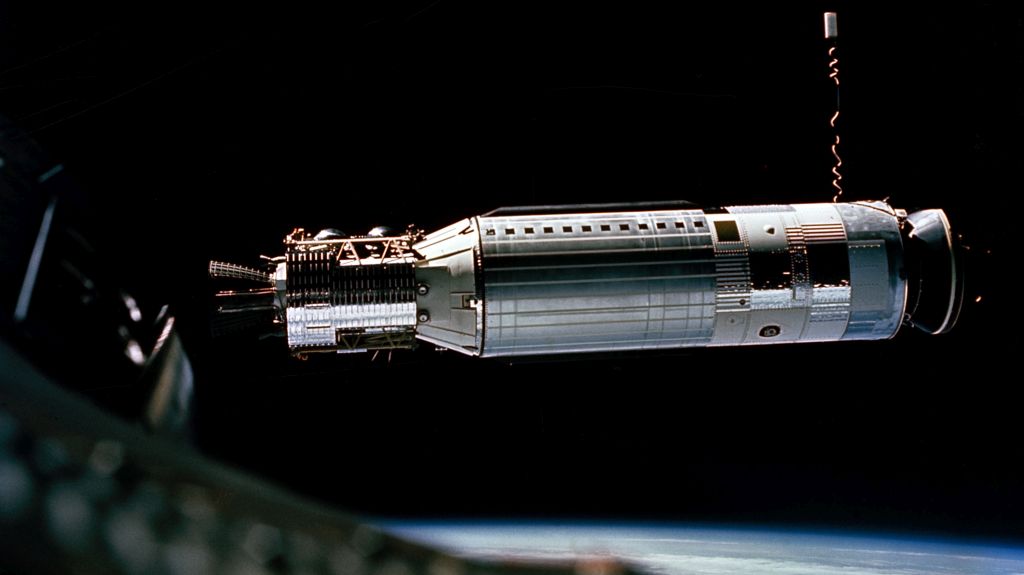
They deorbited to an emergency target about 500 miles east of Okinawa and were picked up by the destroyer USS Leonard Mason (DD-852) after floating alone for two hours in the Western Pacific. Armstrong commented later that the Gemini made a fine spacecraft, but a lousy boat.
Both Armstrong and Dave were bitterly disappointed that all the objectives of the mission were not accomplished, but they were home and safe. Two days after returning to Houston, Armstrong was assigned as backup commander to Pete Conrad on Gemini XI, his final assignment before the Apollo missions began.
In January 1967 NASA suffered a crippling setback when a cockpit fire during Apollo launch pad tests killed astronauts Gus Grissom, Ed White, and Roger Chaffee. As a result of the investigation, the Apollo command module was redesigned over the next year.
In April, on the Monday after NASA’s formal release of the pad accident report, Deke Slayton called together 18 of the astronauts, including Armstrong, and told them that they would be the ones to fly the first lunar missions. He laid out the strategy for the series of early missions, and at the end of the meeting he named the first three crews.
Armstrong was named commander of the backup crew for Apollo 9. In a later shake-up of the schedule, Armstrong was moved up as the backup commander to Frank Borman on Apollo 8, the first flight to circumnavigate the Moon, doing so at Christmastime in 1968. And this put Armstrong in position to command Apollo 11.
NASA’s mid-1962 decision to use Lunar Orbit Rendezvous as the design roadmap for Apollo had mandated the need for a Lunar Module (LM), a contract eventually awarded to Grumman. The Lunar Landing Research Vehicle (LLRV) was intended to provide design input to the LM and the Lunar Landing Training Vehicle (LLTV) to prepare Apollo commanders for the actual landing.
At various points in the project, Armstrong had design input into both vehicles. To familiarize themselves with the lunar landing profiles, the astronauts used helicopters, but their control characteristics were so different from the LM that this approach was discarded as the primary trainer.
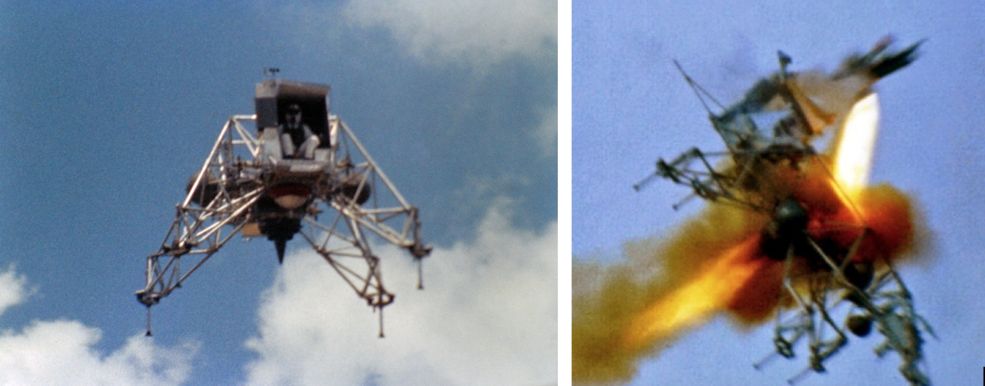
The basic LLRV/TV design included a jet engine, pointing down, which operated at 5/6 of the vehicle's weight, simulating the 1/6 Earth gravity of the Moon. Large downward-firing thrusters, plus multiple but smaller attitude thrusters, all controlled by the crewman as he was strapped into a Weber ejection seat, simulated the LM descent engine and reaction control system. Eventually, two modified LLRVs and three LLTVs were used as trainers at Ellington Air Force Base in Houston.
These were some of the strangest flying machines in the history of aviation. They looked like flying bedsteads—and they proved to be dangerous. On March 6, 1968, Armstrong flew a training flight at Ellington Field in one of the converted LLRVs. As he was making a low approach to landing, the vehicle control began to seriously degrade and then failed completely. The LLRV was below 100 feet, rolling into a 30-degree bank when Armstrong ejected in the last split second. His parachute opened just before he impacted a grassy area adjacent to the runway, and the LLRV was destroyed. Armstrong suffered a bit tongue. An hour later, he was back at his desk in the astronaut office, quietly shuffling papers.
Before the Apollo program was done, three of the five LLTVs were lost in out-of-control ejections. Armstrong flew a total of 27 training missions in them.
With training complete, Apollo 11 lifted off for the Moon from Kennedy Space Center Launch Complex 39 on July 16, 1969, and splashed down 210 nautical miles south of Johnston Atoll in the Pacific on July 24, where the crew was picked up by the USS Hornet (CVS-12).
Armstrong, Aldrin, and Collins spent a full month in quarantine, before and after the historic mission. When they emerged, it was into a different world.
The Apollo 11 astronauts were swamped with relentless media and public attention. In a single day, in mid-August 1969, the astronauts and their families departed Houston on Air Force 2 and attended huge ticker-tape parades in New York City and Chicago. Then they flew to Los Angeles, where President Richard M. Nixon hosted them at the elegant Century Plaza Hotel that evening at a dinner attended by more than 1,000 people. They were presented with the Medal of Freedom by Vice President Spiro T. Agnew at the dinner. The crew later addressed a joint session of Congress, and departed in September on a nonstop 45-day international tour of 23 nations, on every continent except Antarctica.
At the annual meeting of the Society of Flight Test Engineers later that year, Armstrong described the lunar landing to the gathered experimental test pilots. Later at the banquet, he sat next to Charles Lindbergh, who was inducted that year into the Society as an Honorary Fellow.
For about a year, Armstrong served as NASA deputy associate administrator for aeronautics at NASA Headquarters. He initiated a research program on digital “fly-by-wire” control systems that, now matured, have revolutionized much of modern aviation. But he tired of the Washington desk job. Ignoring many high-level offers in business and academia, he returned to Ohio as a professor of aeronautical engineering at the University of Cincinnati, and he and Jan bought a 300-acre farm near Lebanon, Ohio. For the next eight years, he taught in the small aeronautics department at Cincinnati.
In subsequent years, Armstrong turned his attention to corporate life, where he briefly tried his hand as national spokesperson for Chrysler. But his principal interest turned to corporate boardrooms where, over the years, he served as a director for many companies, both in the local area such as Cincinnati Gas and Electric Company, and on the national scene, including United Airlines, Morton Thiokol, and the Eaton Corporation.
Armstrong served on several national studies and commissions, most prominently as vice chairman to former Secretary of State William P. Rogers on the commission to investigate the loss of the Space Shuttle Challenger in 1986. Rogers was “Mr. Outside,” based on his extensive Washington political experience, and Armstrong ran the commission as “Mr. Inside,” principally devoting himself to the technical accident investigation itself.
Throughout his life, Armstrong remained active in flying organizations like the SETP and the Golden Eagles, a small group of former Navy and Marine carrier pilots whose members are legends in the history of naval aviation. He took pride in his membership in the National Academy of Engineering, and was active in several NAE efforts. One was the selection of the Top 20 Engineering Achievements of the Twentieth Century. Armstrong presented the results at the National Press Club, where he said, “Science is about what is; engineering is about what can be.”
In February 1991 Armstrong suffered a slight heart attack while skiing in Aspen, Colorado, but incurred little heart damage. He was released from the hospital the next day, and within six months had passed his private pilot’s license physical with no restrictions.
After a period of separation, Armstrong and Jan’s marriage of 38 years ended with a divorce in 1994. Armstrong later married Carol Knight, a widow whose husband had been killed in a light airplane accident in 1989. Carol was the mother of two children, Molly and Andrew, and she and Armstrong lived in Indian Hill, a suburb of Cincinnati.
After the post-flight parades and the world tour for the Apollo 11 astronauts, Armstrong gradually withdrew from the public eye. He was not reclusive, but as much as possible he sought to lead a private life. He was careful to preserve the positive image and immense accomplishment that he, Collins, Aldrin, as well as the NASA Apollo team had achieved, but he always deflected credit from himself. Though he traveled and often gave speeches, he rarely gave media interviews and avoided the spotlight. He was a quiet, private man, and, at heart, a first-rate aeronautical engineer and test pilot.
Over the years, Armstrong was decorated by 17 nations. In addition to the Presidential Medal of Freedom, he was the recipient of the Congressional Gold Medal, Congressional Space Medal of Honor, Explorers Club Medal, Robert F. Goddard Memorial Trophy, NASA Distinguished Service Medal, Harmon International Aviation Trophy, Royal Geographic Society Gold Medal, Fédération Aéronautique Internationale Gold Space Medal, American Aeronautical Society Flight Achievement Award, Robert J. Collier Trophy, AIAA Astronautics Award, Octave Chanute Award, and John J. Montgomery Award.
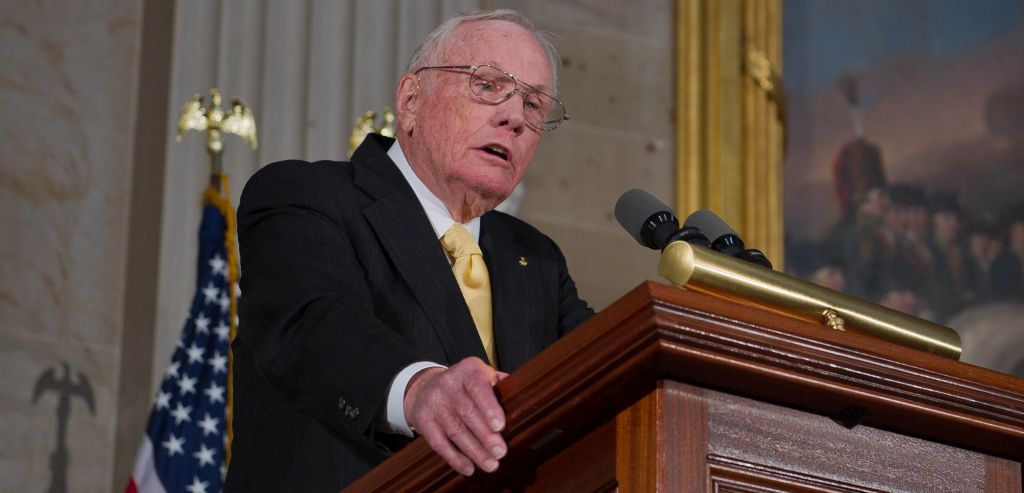
On August 25, 2012, Neil Armstrong died of “complications following a cardiac procedure” according to a family statement. He was 82 years old." The statement continued, “He remained an advocate of aviation and exploration throughout his life and never lost his boyhood wonder of these pursuits…. [A]s much as Neil cherished his privacy, he always appreciated the expressions of good will from people around the world and from all walks of life.”
Remembrances flowed in from across America and the world. Michael Griffin, president of AIAA, summed it up for all of us when he said, “Neil Armstrong showed us how to be famous with dignity, how to be celebrated without becoming a celebrity, and how to do it with a gracious modesty and the unyielding courage to do the right thing as he saw it. We will miss him dearly, not so much for what he did, but for who he was.”
A private service for family and friends was held in Cincinnati. A few days later, the nation said goodbye at a national memorial service at the National Cathedral in Washington, DC, on September 13. Music filled the cathedral, which was overflowing with family, friends, dignitaries, fellow astronauts as well as Golden Eagles, sailors, naval officers, and members of the public.
The following morning with his family on the deck, Neil Armstrong was buried at sea from the USS Philippine Sea (CG-58) in the waters of the Atlantic Ocean. Over the horizon and to the west lay the Kennedy Space Center’s Launch Complex 39, where it all began.
Author’s Acknowledgment
In writing this tribute, I relied on many sources, particularly John Noble Wilford’s New York Times article about Armstrong of August 25, 2012, and Neil’s authorized biography by James F. Hansen, First Man: The Life of Neil A. Armstrong. Several close friends of Armstrong assisted me with edits. A special thanks to Carol Armstrong, to Jan, Rick, and Mark Armstrong, and to Armstrong's sister June Armstrong Hoffman for their gracious help. Most of all, I depended on memories of a man who was my friend for almost five decades. America is fortunate that such a talented, humble, and gracious man was the person who represented her in the most celebrated achievement of the 20th century.
This essay is reprinted courtesy of the National Academy of Engineering, which published it in Memorial Tributes, vol 17, 2013. Washington: National Academies Press.


